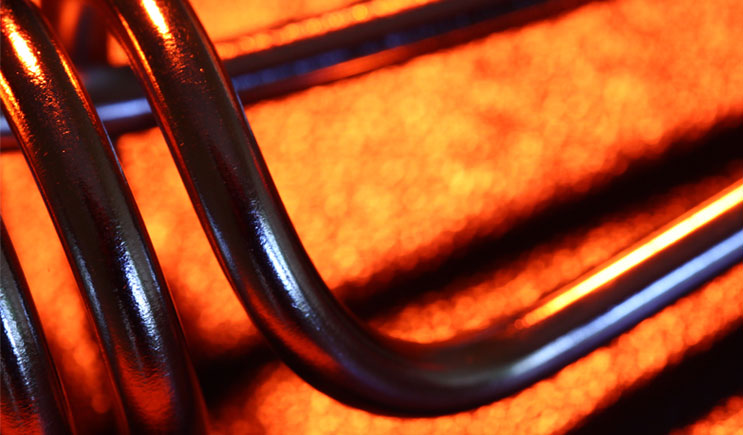Heating Elements
Hi-Temp Products has operated an in-house element fabrication shop for more than 25 years with capabilities to produce a broad range of electric heating element designs and configurations. Our heating elements are made to electrical, physical and atmospheric specifications. As a recognized aftermarket service provider, we’re accustomed to supporting clients who’s furnace equipment is no longer supported by OEMs or outside of OEM Service Agreements and routinely pay to have our Customer’s element shipped to us for characterization and proposed equivalent replacement. We retain an extensive database containing hundreds of furnace OEM heating element specifications. With 75+ years of cumulative application engineering experience, Hi-Temp Products has the capacity to provide application design and engineered solutions for new designs, replacements, upgrades and emergent repair for both new and existing equipment.

Metallic Heating Elements
When dealing with element temperature 50 to 1850°C (120-3360°F) Hi-Temp can manufacture metallic heating elements to any specifications and with short delivery times. Our metallic heating elements are produced using superior quality alloys produced by industry trusted Suppliers like Kanthal Sandvik thus outperforming in all temperature ranges. We can produce in both either round wire, ribbon or strip form and in both Ferritic (FeCrAl) and Austenitic (CrAl) alloys. Below are some of the common elements we produce right here in the USA.
Commonly Fabricated Metallic Elements:
- Coil Wound (spiral & edge wound) Elements
- ROB (rod over bend) formed Elements
- Star Wound “Porcy” Elements
- Tubular Elements (commonly in stainless & Incoloy sheathing)
Common Alloys used to Produce Metallic Elements
Iron-Chromium (FeCrAl) alloys
- Kanthal APM
- Kanthal A-1
- Kanthal AF
- Kanthal D
Nickel-Chromium (NiCr) alloys
- Nikrothal 80
- Nikrothal 70
- Nikrothal 60
- Nikrothal 40
Silicon Carbide Heating Elements
When element temperatures up to 1625°C (2927°F) are required, Silicon carbide (SiC) heating elements are a desirable option with an impressive peak power density of 50 watts per square inch. Electric furnace heating with silicon carbide elements is economical, dependable, clean, quiet and safe. There are no fuel storage problems, no worries about fuel availability and no noxious exhaust products to be ducted away. Silicon Carbide equipped furnaces are versatile. They handle a wide range of products and atmospheres efficiently, and temperatures can be controlled as closely as you like. Silicon carbide heating elements are rigid throughout the range of operating temperatures so they can be installed horizontally or vertically without any additional supports. The single ended connection types allow even greater flexibility in furnace design. They can be installed through side walls or rood, or project up through the hearth or used to heat furnaces that are too wide or too long to span with conventional elements.
Commonly Available SiC Element Grades & Configurations
- Rod & Tubular Elements
- Right Angle Elements
- High Density Rod & Tubular Elements (used in severe applications such as corrosive atmospheres)
- Multi-leg
- Three Phase
- Spiral (Double & Single Ended Connection)
- Heating Element Accessories include terminal straps, clamps, gaskets and feed-throughs
Molybdenum Heating Elements
Molybdenum disilicide (MoSi2) heating elements are the element of choice when the application demands high temperatures beyond what conventional metallic and Silicon Carbide elements can support. With an ability to reach element temperatures of up to 1850°C (3360°F) and watt densities of up to almost 200 watts per square inch, MoSi2 elements are peak performers. MoSi2 is a dense cermet material consisting of MoSi2 and an oxide component of mainly a glass phase and has the ability to withstand oxidation at high temperatures. This is due to the formation of a thin and adhesive protective layer of quartz glass on the surface. When MoSi2 reacts with oxygen in the atmosphere, the layer of quartz glass is formed and under this a thin layer of molybdenum silicide with a lower silicon content Mo5Si3. The silica layer possesses the capacity to “clean itself” from adhering impurities. If the impurities react with silica, the melting point will be lowered. The contaminated layer then flows down the element and literally drips off and a new silica layer is spontaneously formed.
Available MoSi2 Temperature Grades
- 1700 Grade: 1700°C (3090°F)
- 1800 Grade: 1800°C (3360°F)
- 1900 Grade: 1850°C (3360°F)
Available MoSi2 Configurations & Products:
- U Shape
- 90º bend in Hot zone
- 90º bend in Terminal
- Multi-shank Elements
- Custom Shapes
- Accessories: Metallic & Ceramic holders, Plate Holders, Clamps, Straps & Feed-through Assemblies
Vacuum Furnace Heating Elements
Almost all high-temperature vacuum furnaces are electrically resistance heated.The choice of a heating element material depends largely on operating temperature but these elements are most commonly made from high temperature / low vapor pressure materials. This includes refractory metals like Molybdenum and Tungsten as well as Titanium, Tantalum and Graphite. Hi-Temp Products can supply shaped and flat pattern elements and produce elements of all sizes and configurations including rod, strip and round wire. We form, twist, coil, weld, machine and grind components for new designs, replacements, upgrades and emergent repairs.



